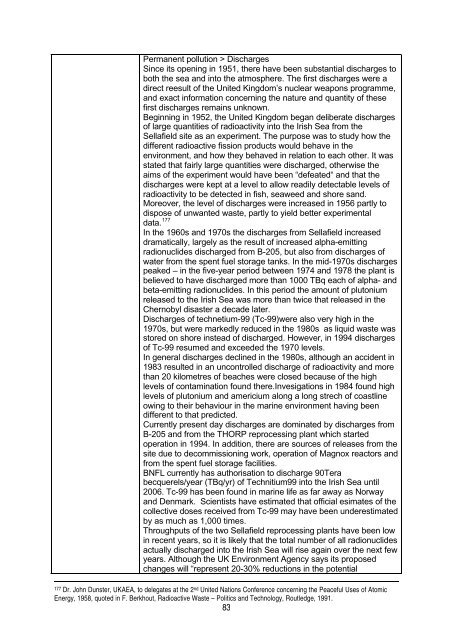Umweltverbrechen multinationaler Konzerne - Greenpeace
Umweltverbrechen multinationaler Konzerne - Greenpeace
Umweltverbrechen multinationaler Konzerne - Greenpeace
Sie wollen auch ein ePaper? Erhöhen Sie die Reichweite Ihrer Titel.
YUMPU macht aus Druck-PDFs automatisch weboptimierte ePaper, die Google liebt.
Permanent pollution > Discharges<br />
Since its opening in 1951, there have been substantial discharges to<br />
both the sea and into the atmosphere. The first discharges were a<br />
direct reesult of the United Kingdom’s nuclear weapons programme,<br />
and exact information concerning the nature and quantity of these<br />
first discharges remains unknown.<br />
Beginning in 1952, the United Kingdom began deliberate discharges<br />
of large quantities of radioactivity into the Irish Sea from the<br />
Sellafield site as an experiment. The purpose was to study how the<br />
different radioactive fission products would behave in the<br />
environment, and how they behaved in relation to each other. It was<br />
stated that fairly large quantities were discharged, otherwise the<br />
aims of the experiment would have been “defeated“ and that the<br />
discharges were kept at a level to allow readily detectable levels of<br />
radioactivity to be detected in fish, seaweed and shore sand.<br />
Moreover, the level of discharges were increased in 1956 partly to<br />
dispose of unwanted waste, partly to yield better experimental<br />
data. 177<br />
In the 1960s and 1970s the discharges from Sellafield increased<br />
dramatically, largely as the result of increased alpha-emitting<br />
radionuclides discharged from B-205, but also from discharges of<br />
water from the spent fuel storage tanks. In the mid-1970s discharges<br />
peaked – in the five-year period between 1974 and 1978 the plant is<br />
believed to have discharged more than 1000 TBq each of alpha- and<br />
beta-emitting radionuclides. In this period the amount of plutonium<br />
released to the Irish Sea was more than twice that released in the<br />
Chernobyl disaster a decade later.<br />
Discharges of technetium-99 (Tc-99)were also very high in the<br />
1970s, but were markedly reduced in the 1980s as liquid waste was<br />
stored on shore instead of discharged. However, in 1994 discharges<br />
of Tc-99 resumed and exceeded the 1970 levels.<br />
In general discharges declined in the 1980s, although an accident in<br />
1983 resulted in an uncontrolled discharge of radioactivity and more<br />
than 20 kilometres of beaches were closed because of the high<br />
levels of contamination found there.Invesigations in 1984 found high<br />
levels of plutonium and americium along a long strech of coastline<br />
owing to their behaviour in the marine environment having been<br />
different to that predicted.<br />
Currently present day discharges are dominated by discharges from<br />
B-205 and from the THORP reprocessing plant which started<br />
operation in 1994. In addition, there are sources of releases from the<br />
site due to decommissioning work, operation of Magnox reactors and<br />
from the spent fuel storage facilities.<br />
BNFL currently has authorisation to discharge 90Tera<br />
becquerels/year (TBq/yr) of Technitium99 into the Irish Sea until<br />
2006. Tc-99 has been found in marine life as far away as Norway<br />
and Denmark. Scientists have estimated that official esimates of the<br />
collective doses received from Tc-99 may have been underestimated<br />
by as much as 1,000 times.<br />
Throughputs of the two Sellafield reprocessing plants have been low<br />
in recent years, so it is likely that the total number of all radionuclides<br />
actually discharged into the Irish Sea will rise again over the next few<br />
years. Although the UK Environment Agency says its proposed<br />
changes will “represent 20-30% reductions in the potential<br />
177 Dr. John Dunster, UKAEA, to delegates at the 2nd United Nations Conference concerning the Peaceful Uses of Atomic<br />
Energy, 1958, quoted in F. Berkhout, Radioactive Waste – Politics and Technology, Routledge, 1991.<br />
83

















